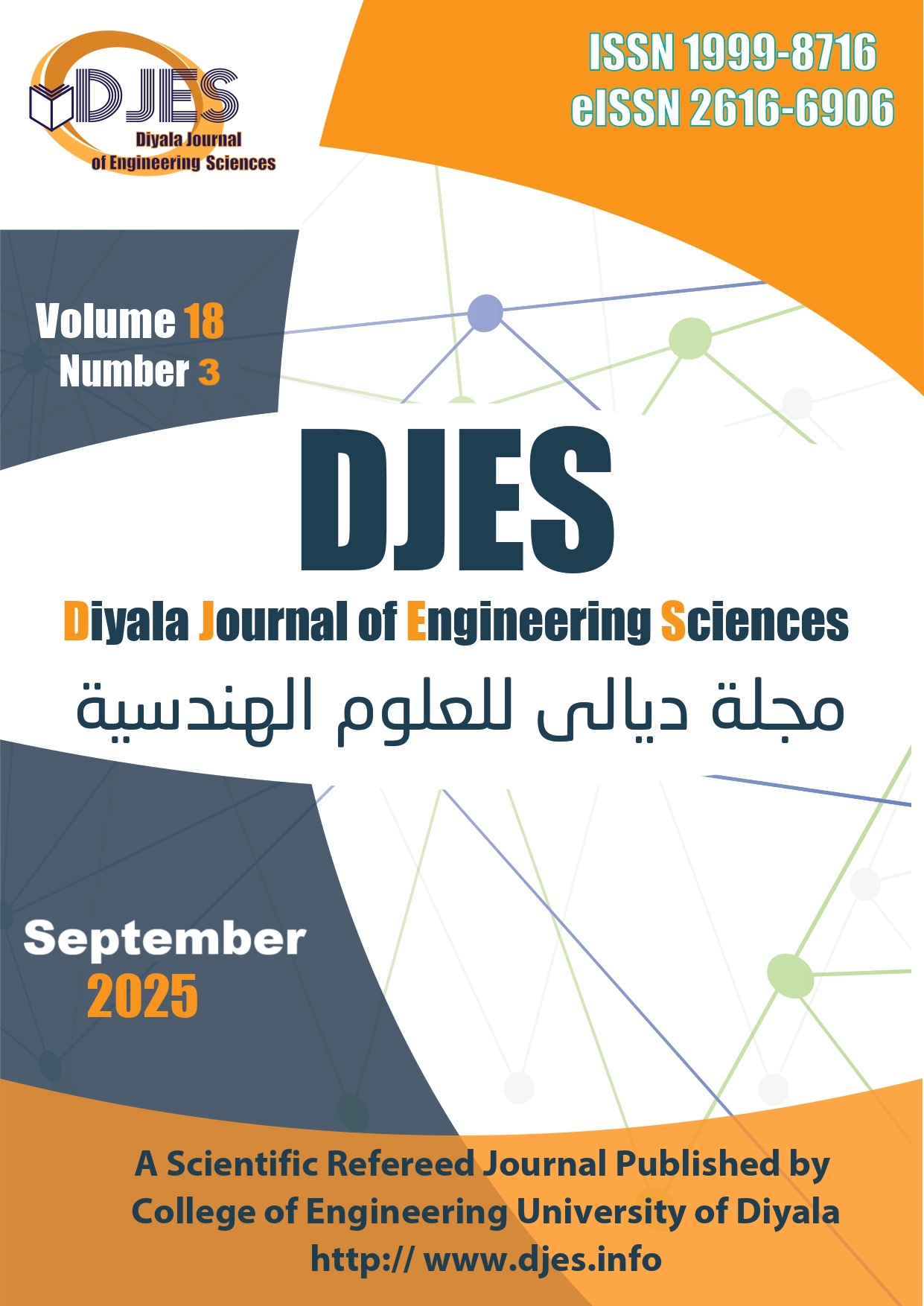Transient Simulation of a Permanent Magnet Synchronous Motor utilizing V/f control aligned with the Park transform
DOI:
https://doi.org/10.24237/djes.2025.18311Keywords:
Permanent magnet synchronous motor (PMSM), Park’s transforms, ,Stationary frame αβ ,Exited frame dq ,Transients period, V/f controller Dynamic Model, MATLAB/SimulinkAbstract
Permanent magnet synchronous motors are widely used in industrial laboratories due to their high starting torque and efficiency compared to static induction machines. The growing interest can be explained by the development of permanent magnet magnetic materials. To evaluate the transient behavior of permanent magnet synchronous motors, a MATLAB model is considered based on the Parke transform to simplify the control strategy that implements voltage-to-frequency (V/f) ratio to maintain more stability during unsteady conditions and facilitate the analysis to track the machine action. Managing this transient phase is essential to prevent excessive inrush currents and ensure stability. This study rigorously examines the behavior of machines during two transition periods until they reach a steady state speed. The rise time (Tr) is the time it takes for a signal to change from (10 - 90) % of its final value. The transient speed duration of the first approach varies between 0.4 ms for the unloaded machine and performs longer duration time 0.7 ms under load conditions. The unloaded machine obviously responds faster than the loaded machine .The second, controlled approach has a limited duration time periods from 10.25 to 10.8 ms, with a rise time of Tr1 = 0.2ms and Tr2 = 2,5ms for both loads applied sequentially. The controlled machine demonstrates a shorter rise time which can be attributed to the same speed root forced to different load conditions. This approach highlighted the benefits of the inherent dc boost voltage to minimize transient effects in synchronous machine.
Downloads
References
[1] J. Du, Y. Yuan, and Y. Wei, “Optimization of Permanent Magnet Machine for Electric Vehicles Considering the Control Strategy and Inverter,” in Proc. 23rd Int. Conf. Electr. Machines and Systems (ICEMS), 2020, pp. 195–200.
[2] C. J. O’Rourke, M. M. Qasim, M. R. Overlin, and J. L. Kirtley, “A Geometric Interpretation of Reference Frames and Transformations: dq0, Clarke, and Park,” IEEE Trans. Energy Convers., vol. 34, no. 4, pp. 2070–2083, Dec. 2019, doi: 10.1109/TEC.2019.2941175.
[3] W. Tong, S. Dai, S. Wu, and R. Tang, “Performance Comparison Between an Amorphous Metal PMSM and a Silicon Steel PMSM,” IEEE Trans. Magn., vol. 55, no. 6, pp. 1–5, Jun. 2019.
[4] J. Park, A. G. Vien, M. Cha, T. T. Pham, H. Kim, and C. Lee, “Multiple transformation function estimation for image enhancement,” J. Vis. Commun. Image Represent., vol. 95, Art. no. 103863, 2023.
[5] G. Goswami and S. Das, “MTPA Based Energy Efficient Strategy for Scalar Control of Induction Motor Drives,” in *Proc. 2024 IEEE 4th Int. Conf. Sustainable Energy Future Electr. Transp. (SEFET)*, Hyderabad, India, Jul. 2024, pp. 1–6, doi: 10.1109/SEFET61574.2024.10717481.
[6] K. K. Dutta, A. Devanshu, and S. Allamsetty, “Scalar-controlled three-phase induction motor drive using FPGA-based WAVECT controller,” in Proc. 2024 3rd Int. Conf. Power Electron. and IoT Applications in Renewable Energy and its Control (PARC), Feb. 2024, pp. 264–268.
[7] M. Hassan and M. Jovanovich, “Improved scalar control using flexible DC-Link voltage in Brushless Doubly-Fed Reluctance Machines for wind applications,” in Proc. 2nd Int. Symp. Environ. Friendly Energies and Applications (EFEA), Newcastle Upon Tyne, UK, 2012, pp. 482–487, doi: 10.1109/EFEA.2012.6294037.
[8] Y. L. Zhukovskiy, B. Y. Vasilev, and B. Korolev, “The behavior of asynchronous electric drive with a closed scalar control system when changing the inductance of the magnetizing circuit,” Indones. J. Sci. Technol., vol. 8, no. 1, pp. 65–78.
[9] B. G. Cho, C. Hong, J. Lee, and W. J. Lee, “Simple position sensorless V/f scalar control method for permanent-magnet synchronous motor drives,” J. Power Electron., vol. 21, no. 7, pp. 1020–1029, 2021.
[10] X. Wang et al., “General Modeling and Control of Multiple Three-Phase PMSM Drives,” IEEE Trans. Power Electron., 2024.
[11] A. L. O. Vitor, P. R. Scalassara, A. Goedtel, and W. Endo, “Patterns based on Clarke and Park transforms of wavelet coefficients for classification of electrical machine faults,” J. Control Autom. Electr. Syst., vol. 34, no. 1, pp. 230–245, 2023.
[12] J. Liu and W. Chen, "Generalized DQ model of the permanent magnet synchronous motor based on extended park transformation," 2013 1st International Future Energy Electronics Conference (IFEEC), Tainan, Taiwan, 2013, pp. 885-890, doi: 10.1109/IFEEC.2013.6687627.
[13] M. S. Hasan, F. S. Almakhturi, M. D. Albakhait, and A. I. Jaber, “High Performance Rectifier/Multilevel Inverter Based BLDC Motor Drive with PI Controller,” IOP Conf. Ser.: Mater. Sci. Eng., vol. 22–23, 2019.
[14] Zhang, P., Shi, Z., Yu, B. and Qi, H., 2024. Research on a sensorless adrc vector control method for a permanent magnet synchronous motor based on the luenberger observer. Processes, 12(5), p.906.
[15] S.-Y. Im, K.-S. Cha, Y.-J. Won, Y.-Y. Choi, and M.-S. Lim, “Two-Step Optimum Design Process of PMSM to Improve Driving Efficiency and Harmonics of Lightweight Electric Vehicle,” IEEE Trans. Ind. Appl., 2023.
[16] C.-S. Park, J.-H. Kim, S.-H. Park, and M.-S. Lim, “Effect of electromagnetic force caused by PMSM on the vibration/noise of reciprocating compressors,” IEEE Access, vol. 11, pp. 56324–56335, 2023;
[17] Krupa, T. M., et al. "Interior Permanent Magnet Synchronous Motor for EV Applications." 2024 8th International Conference on Computational System and Information Technology for Sustainable Solutions (CSITSS). IEEE, 2024.
[18] H. S. Hameed, Q. Al Azze, and M. S. Hasan, “Speed control of switched reluctance motors based on fuzzy logic controller and MATLAB/Simulink,” Indones. J. Electr. Eng. Comput. Sci., vol. 31, no. 2, pp. 647–657, 2023.
[19] Song, Won Seok, and Seungjae Min. "Robust topology optimization of interior permanent magnet synchronous motor for torque ripple reduction under current uncertainty." Applied Mathematical Modelling 140 (2025): 115917..
[20] Z. He and T. Shinshi, "Torque Regulation Theory and Sensorless Control Technology for Unipolar Salient Synchronous Permanent Magnet Motor Based on Unified Models," in IEEE Transactions on Power Electronics, vol. 40, no. 4, pp. 5672-5684, April 2025, doi: 10.1109/TPEL.2024.3495715
[21] G. Yun, Y. Choo, C. Kim, S. Lee, D.-K. Hong, and C. Lee, “Vibration analysis of a permanent magnet synchronous motor by a pole/slot combination,” AIP Adv., vol. 13, no. 2, 2023.
[22] R. A. Mejeed, M. S. Hasan, A. I. Jaber, and A. N. Almakki, “New Scheming Approach of Switching Gates Based DC-Link Controller,” in Proc. 2023 Seminar Ind. Electron. Devices Syst. (IEDS), Saint Petersburg, Russia, 2023, pp. 177–180, doi: 10.1109/IEDS60447.2023.10425998.
[23] R. Bharti, M. Kumar, and B. M. Prasad, “V/F Control of Three Phase Induction Motor,” in Proc. 2019 Int. Conf. Vision Towards Emerging Trends Commun. Netw. (ViTECoN), Vellore, India, 2019, pp. 1–4, doi: 10.1109/ViTECoN.2019.8899420.
[24] J. Liu and W. Chen, “Generalized DQ model of the permanent magnet synchronous motor based on extended Park transformation,” in Proc. 2013 1st Int. Future Energy Electron. Conf. (IFEEC), Tainan, Taiwan, 2013, pp. 885–890, doi: 10.1109/IFEEC.2013.6687627.
[25] M. Inoue and S. Doki, “PMSM Model Discretization in Consideration of Park Transformation for Current Control System,” in Proc. 2018 Int. Power Electron. Conf. (IPEC-Niigata 2018 -ECCE Asia), Niigata, Japan, 2018, pp. 1228–1233, doi: 10.23919/IPEC.2018.8507948.
[26] Y.-R. Lee and S.-K. Sul, “Switching Frequency Signal-Injection Sensorless Control in Dual Three-Phase PMSM Robust to Non-Ideal Characteristics of Inverter System,” IEEE Trans. Power Electron., 2024.
[27] C. Chen, Y. Chen, X. Yang, S. Gao, and B. Zhang, “Inverter Fault Detection Method Based on Park Transformation and K-means Clustering Algorithm,” in Proc. 2021 CAA Symp. Fault Detection, Supervision, and Safety Tech. Process. (SAFEPROCESS), Chengdu, China, 2021, pp. 1–6, doi: 10.1109/SAFEPROCESS52771.2021.9693715.
[28] F. V. Lopes, D. Fernandes, and W. L. A. Neves, “A Traveling-Wave Detection Method Based on Park’s Transformation for Fault Locators,” IEEE Trans. Power Del., vol. 28, no. 3, pp. 1626–1634, Jul. 2013, doi: 10.1109/TPWRD.2013.2260182.
[29] S. A. Kim, J. H. Song, S. W. Han, and Y. H. Cho, “An Improved Dynamic Modeling of Permanent Magnet Synchronous Machine with Torque Ripple Characteristics,” J. Clean Energy Technol., vol. 6, no. 2, p. 4, 2018.
[30] M. A. Rahman and T. A. Little, "Dynamic Performance Analysis of Permanet Magnet Synchronous Motors Magnet Synchronous Motors," in IEEE Transactions on Power Apparatus and Systems, vol. PAS-103, no. 6, pp. 1277-1282, June 1984, doi: 10.1109/TPAS.1984.318460.
Downloads
Published
Issue
Section
License
Copyright (c) 2025 Mohammed S. Hasan, Assama S. Jafar , Ahmed I Jabber

This work is licensed under a Creative Commons Attribution 4.0 International License.












